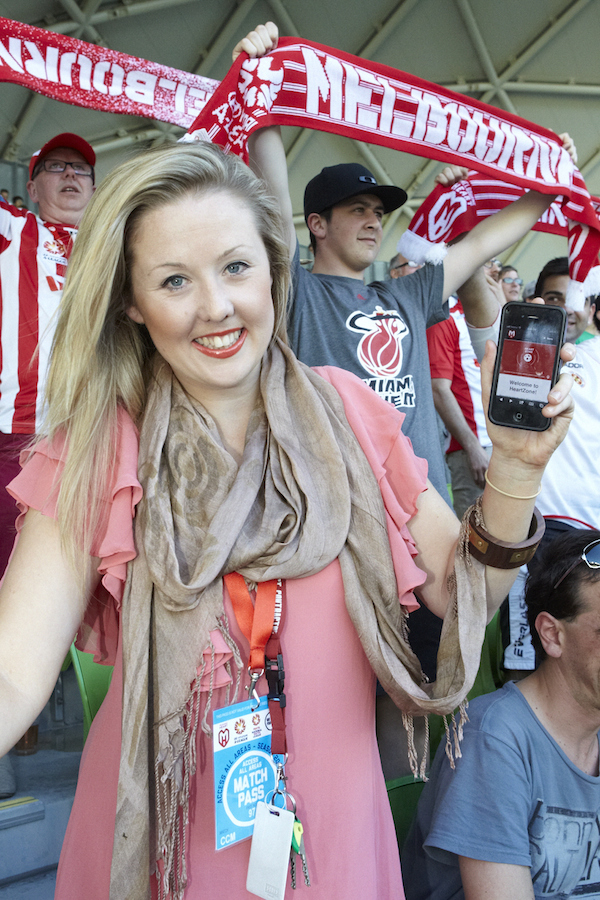Uniti Wireless brings the lounge-room experience to the stadium

Strong usage of a new sports-information system at Melbourne's AAMI Park has validated an Adelaide company's plan to bring high-capacity WiFi networks and related content to fans at major stadiums across the country.
Since Uniti Wireless' Uniti Play system went live in AAMI Park in early August, between 10 and 15 percent of fans have signed onto the company's WiFi network during matches to access a range of interactive content about players and teams, as well as sponsors' competitions.

Because such information is so widely available during televised broadcasts, many fans were increasingly staying home rather than heading to the stadium.
“Most sporting teams in Australia are struggling to get numbers,” explains co-founder and executive director Che Metcalfe.
“The main reason for this is that fans believe the experience at home is better. They have high-definition widescreen TVs they can use for social media, and have two screens going at the same time."
"In the US they've moved to provide social media over WiFi, to provide a BYOD environment so people can have the same experience at the stadium – but during a live game.”
The Uniti Play rollout was commissioned by the National Rugby League for the Melbourne Storm's home final, after a successful trial at the Melbourne Storm's last game of the season and a later deployment for the Melbourne Heart soccer team.
AAMI Park NRL, A-League and Super 14 attendance averages around 13,393 fans, with a record of 29,442 set at the Kangaroos vs New Zealand test match in May 2010.
That potentially provides big numbers for engagement with online services, says Uniti Wireless executive director and co-founder Sasha Baranikov.
“Smartphones have the highest level of engagement of any type of engagement,” she says. “These people are quite quickly logging on and latch on to new marketing trends like this. But we'll see it increase with further awareness, and as more teams come onboard and it becomes a known and done thing.”
Importantly for the company – whose business model is built around attracting advertisers and sponsors for the content – more than 80 percent of people who sign up are actually using the system to engage with the content, and more than 60 percent of users are return visitors.
Such figures mean that “as an advertising medium, this is more valuable than signage at a stadium,” Metcalfe says, noting that advertisers value the ability to identify and interact with each individual at a match.
"When you have an interactive platform with a captive audience that is potentially watching a match – and looking for relevant information during the match and something to do during the break – the ability to get all of those people to engage with you is a very tempting offer for advertisers."
“One of their biggest problems with fan engagement is that they normally only get the data from the person who buys the ticket,” he explained. “What they don't have is the data about the other people that turn up for the game.”
“When you have an interactive platform with a captive audience that is potentially watching a match – and looking for relevant information during the match and something to do during the break – the ability to get all of those people to engage with you is a very tempting offer for advertisers.”
That will, in Uniti Wireless' calculations, help attract more content and competition sponsors – which will in turn continue to increase fan usage of the WiFi system.
Uniti Wireless has purpose-built the environment to scale for up to 30,000 simultaneous users, with a large number of switchable 2.4GHz/5GHz arrays enabling utilisation to be balanced and adjusted according to usage demands. Each array has the equivalent of 16 WiFi access points, allowing for extremely high numbers of simultaneous connections without impacting network performance.
“When we come to a stadium we look at the mix of older 2.4GHz phones compared to newer 5GHz phones,” Metcalfe said, “and we have the statistics on that from the matches we've done. Over time, we can adjust the amount of 5GHz compared with 2.4GHz; over time, it will get the point where there's no 2.4 left.”
Performance has also been boosted by hosting content on local servers and blocking fan access to bandwidth-heavy services.
This design had lowered the deployment cost of the UnitiPlay system, he added, which gave stadium operators the flexibility to experiment with content and advertising models without investing millions to deploy hundreds of WiFi access points around the venues.
That capability, paired with the demonstrably high rates of fan engagement, is expected to make interactive fan systems increasingly popular in other major venues across the country: Uniti Wireless is already looking at similar setups in other major capital-city stadiums, and is also in talks with organisers of other high-density events such as music festivals and wine festivals.